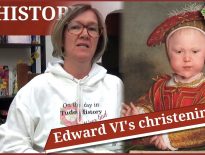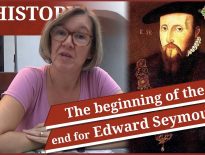On this day in Tudor history, 14th October 1586, in the reign of Queen Elizabeth I, the trial of Mary, Queen of Scots, began at Fotheringhay Castle in Northamptonshire.
Although Mary did not recognise the authority of the commission and had threatened not to attend, she had been informed that the trial would go ahead with or without her and so attended.
Find out all about Mary's trial, what she was charged with and the evidence that Sir Francis Walsingham had gathered in today's talk.
Mary, Queen of Scots was, of course, executed at Fotheringhay on 8th February 1587 and you can find out about her execution in my talk from 8th February:
You can find out more about Mary, Queen of Scots' downfall in my two-part Claire Chats series:
- Elizabeth I and the fall of Mary, Queen of Scots
- Elizabeth I and the fall of Mary, Queen of Scots - Part 2
Also on this day in history:
- 1536 – Pilgrimage of Grace. By 14th October the uprising in the north had turned into a proper rebellion. On 13th October, Lord Darcy had reported to Henry VIII that the East Riding, West Riding, North Riding and “all the commons of Yorkshire” were “up” in rebellion, and on 14th October William Haryngton, Mayor of York, and Sir George Lawson, wrote to the King asking for aid because “the commons… have rebelliously assembled to take York”.
- 1559 – Death of John Williams, Baron Williams and Lord President of the Council in the Marches of Wales, at Ludlow Castle. He was buried in Thame Church.
- 1565 – Statesman and poet, Thomas Chaloner, died at his home in Clerkenwell, London. During the reign of Elizabeth I he acted as the English ambassador to Ferdinand I, Holy Roman Emperor, in 1558, and then ambassador to Philip II in the Low Countries, and then Spain between 1559 and 1561. Chaloner was a great friend of William Cecil, Lord Burghley. In 1564, his health began to fail, and he was allowed to return home. He died there on the 14th October 1565, aged forty-four.
- 1593 – Death of Arthur Grey, 14th Baron Grey of Wilton, soldier and Lord Deputy of Ireland, at his home of Whaddon in Buckinghamshire. He was buried there. Grey had a reputation for radical Protestantism.
- 1596 – Death of John Coldwell, Bishop of Salisbury, at Salisbury. He was buried in the cathedral, in the grave of Bishop Wyvil due to his state of poverty.



The trial of Mary, Queen of Scots is the second biggest farce of Tudor history, following the trial of Anne Boleyn, who was also set up.
Walsingham claimed to have lots of evidence but didn’t present any of it for the Queen to inspect. Yes, it was up to the accused to give answer, not the prosecution, but in certain state trials one suspects the rules are abandoned because the person is a real threat to the crown who fear they are more popular than them. The trial of Mary Queen of Scots was one such time because even if the men were guilty, there is considerable doubt over her consent to the death of Queen Elizabeth. Mary wanted her freedom, but she always stated she hadn’t wanted Elizabeth dead. Of course she probably couldn’t wait for Elizabeth to die naturally as she was next in line or so she believed, but that is entirely different to wanting to kill her cousin.
Sir Anthony Babington was, in my judgement, delusional. He was a devoted Catholic gentlemen, excluded from power, persecuted by fines and he was dreaming of an ideal world which was beyond reality. His five companions were of similar ilk. They were all young radicals with nothing to do. The men behind the gunpowder plot were the same, passionate, idealistic, radical and devout young men, with a cause and they couldn’t even be turned from their purpose, even after the plot failed. They had a cause and were single minded about it. Mary was an alternative to Elizabeth on their doorstep; she was a Catholic Queen and she had a son who could unite England and Scotland; she would end decades of Catholic persecution and they were probably also romantically in love with her. Mary saw these men as her deliverance from 18 years of imprisonment without trial. I guess that if she did consent then she was desperate for freedom and deliverance.
Mary gave very intelligent answers and she conducted herself well and it sounds as if Walsingham was worried because he simply couldn’t actually provide enough proof and he continued to refuse Mary anything she requested sight off. He was worried in case anything went wrong because he and Cecil had staked their reputations on the three weeks of coded letters hoping Mary would consent, but when she did, it was ambiguous and now the letter is believed to have been added to by him and some historians question the validity of any of the so called evidence. Mary had to be found guilty and condemned and Cecil and Walsingham would go to any lengths to make it so.